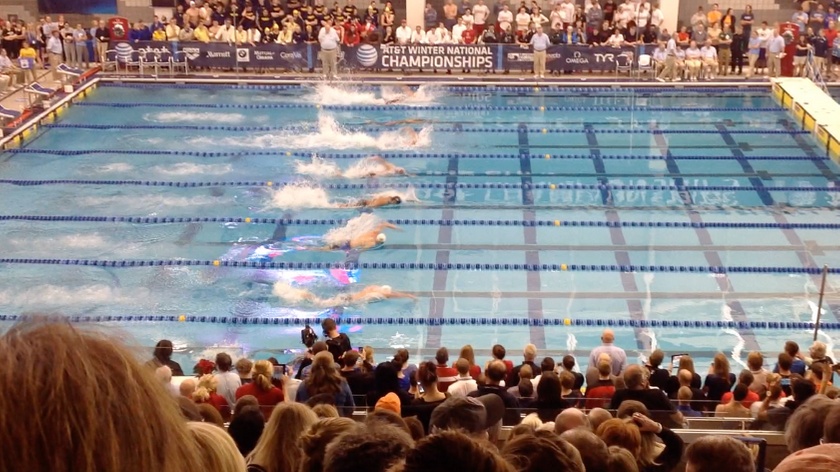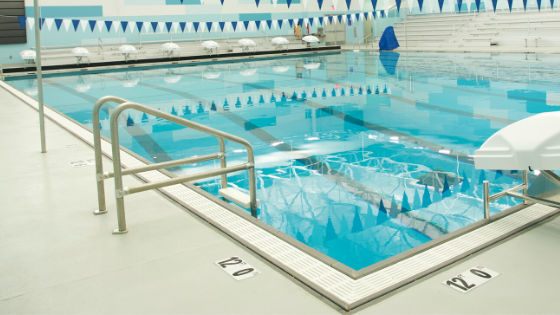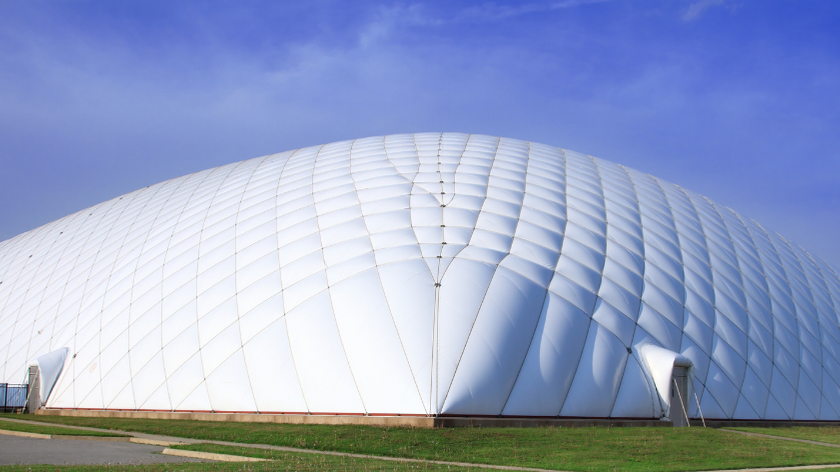How Big is an Olympic Swimming Pool?
An Olympic sized swimming pool is 50 meters long, and at least eight lanes wide. The official dimensions of an Olympic swimming pool are are defined by FINA, the international governing body for the sport of swimming.
Surprisingly few people outside of the competitive swimming world know the difference between an Olympic swimming pool and an ordinary lap pool. We often hear from clients that claim to have "an olympic length pool", but they almost always mean a 25-yard lap pool. This article will clear up any confusion over swimming pool dimensions so that you can know the differences in sizes of swimming pools.
Downloadable PDF: FINA Official Facility Rules
Swimming pool dimensions
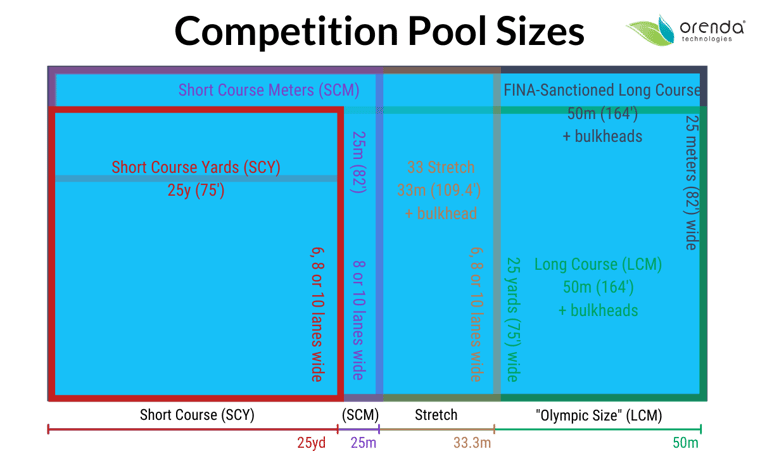
We will focus on pools with lap lanes only. Recreational pools with play areas and lazy rivers will be excluded from this because those pools do not host swimming, diving, or water polo competitions. Keep in mind that American swimming pools use yards and meters, but internationally, only meters are used.
Short Course (SCY, SCM)

Short Course Yards (SCY) is 25 yards long. SCY is a standard distance for USA Swimming, high school and collegiate meets in the United States.

- Minimum 6 lanes (summer league, recreation)
- Minimum 8 lanes (sanctioned)
- Minimum 1 meter (3.28 ft) depth, and 1.35 meter (4.43 ft) depth for starting blocks
- 25 yards (75 ft) or 25 meters (82 ft) long
SCY: Short Course Yards (USA only)
In the United States, most competitive swimming pools are 25 yards long. This is the most standard length competition pool, and the one most commonly mistaken for an Olympic sized pool (by those who were not competitive swimmers). Most US high schools, public recreation centers, universities and YMCA's have 25-yard pools. Swimmers refer to this type of pool as "short course", or "short course yards". On paper, the acronym is SCY.
For non-championship meets (recreational, high school and college dual meets), 6 lane SCY pools can be used. This allows 3 swimmers from each team, staggered by lane (1,3,5 vs. 2,4,6). Sanctioned championship meets, however, must have 8 lanes (or more). These pools are usually at least 60 feet wide, based on 7' or 8' lane widths, and whether or not there are gaps between outside lanes and the pool walls.
For officially-sanctioned USA Swimming and NCAA/NAIA meets, a 25-yard pool must also have approved timing touchpads that hang on the wall where the swimmers touch and turn. These touchpads are approximately one centimeter to half an inch thick (1.0 cm to 0.5 in), depending on the brand. So the pools that host sanctioned swim meets must be slightly larger than 25 yards to accommodate the touch pads. Touchpads are also used for any sanctioned meet in meters.
Related: What is a Natatorium?
SCM: Short Course Meters (Int'l short course, USA outdoor summer league pools)
Most outdoor community pools–such as homeowner association (HOA) neighborhood pools–are actually 25 meters long. The acronym for Short Course Meters is SCM. These types of pools are the ones that host summer swimming leagues. One of the largest outdoor summer swimming league, for example, is the Northern Virginia Swim League (NVSL). NVSL pools are almost all 25 meters long, and the records and official meets are in SCM. Depths vary, as do coping stone shapes and sizes, but length does not. In fact, the oldest NVSL records on the books are the ones in SCY, because those pools no longer exist (with maybe one or two exceptions).

Summer League swimming is usually Short Course Meters (SCM), which is 25 meters with no touchpads.
Outdoor summer swim leagues tend to not use touch pads (volunteer timers instead), so the pools are usually made exactly 25 meters long. Lap lanes are divided by lane lines that are usually seven feet apart, but on larger pools can be 8 feet wide. The international FINA standard lane width is 2.5 meters (8.2 feet). The narrowest common lane width is 6.5 feet.
Long Course (LCM)

US Olympic Trials in 2016 in Omaha, Nebraska. An official Olympic Sized pool is 50 meters long by 25 meters wide.

- Minimum 8 lanes (US sanctioned). In the US, most commonly 25 yards wide.
- Minimum 10 lanes (FINA sanctioned). Internationally, most commonly 25 meters wide.
- Minimum 2 meters (6.56 ft) deep
- 50 meters (164 ft) long
A true "olympic pool" is long course meters (LCM). Long course is the standard for international competition, with the exception of a few international short course championships, like the Duel in the Pool, Short Course World Championships, International Swimming League (ISL), and the FINA World Cup.
And if you were wondering, there is no such thing as long course yards. Long course is always in meters.
Most Long Course Pools do not meet FINA standards for width

Greensboro Aquatic Center (GAC) is a premier aquatic center in the country. It is 50m long by 25yds wide, and therefore does not meet FINA standards. Nevertheless, GAC hosts USA Swimming, NCAA, YMCA and Masters national championships, and the LCM times count.
There are a few essentials that make a true Olympic pool different just any long course pool. The main differences are depth requirements, lane widths, and the actual width of the pool itself. FINA-sanctioned long course pools must be at least 2.0 meters deep throughout, and must be 25 meters wide, with 2.5 meter lanes.
But in the United States, because we swim in yards (and no other nation does), our LCM pools in universities and public aquatics centers are usually 25 yards wide. Therefore, most long course pools in the USA are not able to host FINA-sanctioned international meets like the World Championships or the Olympics. But don't worry, we make temporary pools for those big events anyway, just like US Olympic Trials. This pool construction was done by Spear Corporation.
The 25 yard width is for practical purposes, so that when the pool is not set up in long course format, the pool can have 20+ lanes of short course yards. More than one swim team can use a big pool this way. Making our pools 25 meters across would add over 50,000 more gallons (190 m3). So the costs are higher to operate the pool, and for less utility.
Also for practical purposes, almost all long course pools have dividing walls–called bulkheads–that can be moved.
 Bulkheads are movable bridges, shown here with an official standing on it.
Bulkheads are movable bridges, shown here with an official standing on it.
These bulkheads allow for multiple setups. For instance, a pool could have a meet from wall to bulkhead, and warmup lanes on the other side of the bulkhead. Bulkheads are moved to opposite ends of the pool when long course racing occurs. This means that most olympic-sized swimming pools have two bulkheads, and are built larger than 50 meters to accomodate the width of the bulkheads.
In most American university aquatic centers, bulkheads range from 3.5 to 6 feet in width. They can be rolled and anchored into multiple locations for different racing setups. Here's a cool video of MIT's pool being switched from short course to long course:
LCM times still count
Just because American LCM pools cannot host FINA-sanctioned meets, they can host USA Swimming sanctioned meets. Provided the pool complies with USA Swimming pool standards, and the event is a USAS-sanctioned meet, long course times still count as official times.
Downloadable PDF: USA Swimming Pool Standards and Dimensions
Less-common sizes of competition pools
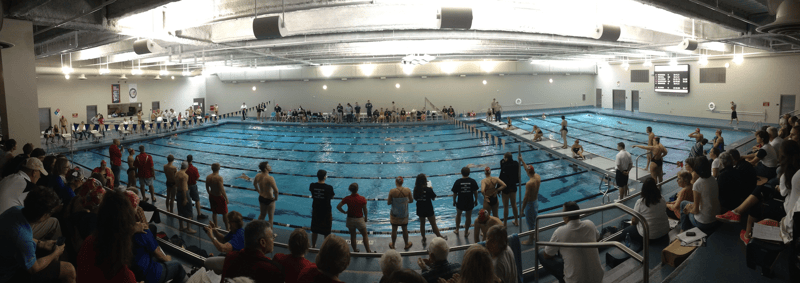
Queens University's pool is considered a "Stretch 33", because it can stretch to 33.3 meters by moving the bulkhead.
- Moveable bulkhead allows for SCY and SCM competition
- Water available on the opposite side of the bulkhead
- Some stretch to 33.3 meters for 3-lap training (3 laps = 100 meters)
By far and away, the most common competition pool in America is short course yards (SCY). Internationally, however, everything is in meters, so you have a mix of long course meters and short course meters. But you also have something in between. We call these pools "stretch" pools. As in "33 stretch" or a "25 stretch." A stretch just means there is more water on the other side of a moveable bulkhead. For instance, a SCY pool could have a bulkhead, and another 15 yards for a diving well, or a shallow end for lessons.
The photo above is of Queens University in Charlotte. It is a stretch 33 pool, meaning the bulkhead can be moved to the end for 33.33 meters. It is designed to be one third of 100 meters. This allows 3 laps to equal 2 laps in LCM, or 4 laps in SCM. It's right in between. But most of the time, the bulkhead is set up for SCY training and competition.
Internationally, stretch 33 pools are more common than they are in the United States.
Conclusion
Olympic pools are few and far between. For one thing, they are huge. They have more than twice the amount of water of a typical short course yards pool, and more than twice the costs of operation. So naturally, there are far more short course pools in the United States. Short course pools are much more affordable, practical, and can host just about any competition except long course meets.
People outside of the competitive swimming community often consider 25 yard or 25 meter short course pools to be Olympic sized, but that is incorrect. Only 50 meter long course pools are considered olympic sized. And yes, we consider 50m x 25yd pools to meet the criteria of Olympic sized, even though they cannot host FINA-sanctioned international meets. Who cares? The qualifying times still count.
So the next time someone (like a realtor) boasts that the neighborhood pool is olympic sized, now you know the difference.
Water clarity before and after Orenda CV-600 Enzymes.

 By
By

